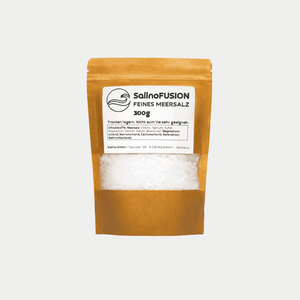When air becomes medicine
There are places in the world where breathing alone is therapeutic. Where salty sea spray hangs in the air, the wind carries a mist of minerals, and a deep breath brings more relief than many medications. Anyone who has ever stood by the North Sea and felt their bronchi open knows what I'm talking about.
Salt air therapy—also known as halotherapy or aerosol therapy—has been a silent companion throughout medical history. Its path leads from the salt-encrusted depths of Polish mines to the ultramodern living rooms of people seeking relief. And yet hardly anyone knows its full story.
In this article, we trace the five major stages of this healing tradition—from its origins in caves and monasteries, through the medical boom in the 19th century, to today's renaissance in the everyday lives of chronically ill people. It's a story of dust and salt, of shortness of breath and hope—and of a natural substance that has never fallen out of time.
The origins: Salt as a medicinal remedy for indigenous peoples
 Long before salt appeared in fine shakers on dining tables, it was a substance of myth. For many ancient cultures, salt was a symbol of life—precious, purifying, protective. In early medicine, it played a special role: not just as a preservative, but as a substance with healing effects on body and soul.
Long before salt appeared in fine shakers on dining tables, it was a substance of myth. For many ancient cultures, salt was a symbol of life—precious, purifying, protective. In early medicine, it played a special role: not just as a preservative, but as a substance with healing effects on body and soul.
In Egypt, salt was used not only for embalming but also as an ingredient in healing ointments. In ancient China, saline steam was considered a remedy for respiratory problems—a tradition that was linked to ritual steam baths in Taoism. Greek physicians like Hippocrates also praised the healing power of saline air. He is said to have been the first to recommend sending patients with respiratory illnesses to seashores—an instruction that sounds astonishingly timeless.
But it wasn't only the upper classes who enjoyed the salt air. In medieval times, it was believed that staying in salty rock caves cleansed the lungs. Miners considered salt mines to be places of strange health: While other professions were plagued by tuberculosis, many salt workers were spared.
It was more than a coincidence. Without knowing it, they inhaled fine particles every day that had an antiseptic effect, loosened mucus, and cleared their airways. The salt mine became a quiet health resort—invisible, underground, but effective.
In Eastern Europe, especially in Poland, Hungary, and Ukraine, this has given rise to a folk medicine based on salty air over the centuries. Even today, underground healing tunnels are still in operation there, where people suffering from asthma, bronchitis, or atopic dermatitis sleep for nights – deep underground, surrounded by salt.
The medical revolution: How folk healing became science
 The turning point came—as so often in the history of medicine—by chance, coupled with careful observation. In 1843, the Polish physician Dr. Feliks Boczkowski published his experiences working in the Wieliczka salt mines near Kraków. He had noticed that salt miners suffered noticeably less from respiratory illnesses—despite the harsh working conditions underground. Instead, they seemed more robust, less plagued by coughs, and more free-breathing.
The turning point came—as so often in the history of medicine—by chance, coupled with careful observation. In 1843, the Polish physician Dr. Feliks Boczkowski published his experiences working in the Wieliczka salt mines near Kraków. He had noticed that salt miners suffered noticeably less from respiratory illnesses—despite the harsh working conditions underground. Instead, they seemed more robust, less plagued by coughs, and more free-breathing.
Boczkowski's report was groundbreaking: He was the first to systematically link inhalation exposure to salty air with health benefits. His work, "On the Effects of Exposure to Salt Mines on the Health of Workers," became the foundation of modern halotherapy.
Shortly thereafter, the first "salt clinic" opened in Wieliczka – an underground sanatorium where patients spent the night in the salty atmosphere. It was a radical idea: healing not through medicine, but through the environment, through air, temperature, humidity – through breathing.
From Poland, the idea spread quickly. Health resorts with artificially recreated salt caves or graduation towers also sprang up in the Austro-Hungarian region, Germany, and Russia. The latter—originally intended for salt extraction—were now specifically used to generate saline air. Brine trickled down blackthorn walls, evaporating into fine aerosols that visitors inhaled like sea spray.
The lungs became the focus of a new, environmentally oriented approach to medicine: Instead of administering medications to treat symptoms, attempts were made to change the environment surrounding the body. Air became therapy. Salt became the medium.
But even though initial medical evidence was being collected, salt air therapy remained for a long time on the border between science and empirical medicine—respected but not institutionalized. It wasn't until the emergence of pulmonology as an independent specialty that halotherapy received new impetus.
The silent renaissance: salt in modern respiratory medicine
In the 20th century, salt air therapy remained quiet for a long time. Modern medicine was experiencing its pharmaceutical heyday: penicillin, cortisone, asthma inhalants. The vision that air alone could heal suddenly seemed romantic and backward. And yet, the method continued to be used in rehabilitation centers and healing caves in Eastern Europe – quietly, unobtrusively, but with steady demand.
Halotherapy has only been gaining renewed attention in Western countries since the 1990s. The reason? The increase in chronic respiratory diseases. Asthma, COPD, hay fever – these are now widespread illnesses. At the same time, sensitivity to environmental factors is increasing: particulate matter, dry heating air, harsh chemicals – our breath is becoming the barometer of our times.
Doctors and patients are once again beginning to look beyond traditional pharmacology for support. Studies show that saline aerosols can help loosen trapped mucus, stimulate the lungs' self-cleansing processes, and alleviate inflammatory processes. Especially with chronic diseases, the goal is not to cure in the traditional sense, but rather to improve quality of life: breathing more freely, coughing less, sleeping better.
In Germany, it's primarily graduation towers that are embracing this trend – for example, in Bad Salzuflen, Bad Dürkheim, or Bad Kösen. Visitors stroll through salt-misted pavilions, breathe deeply, and often feel a change within minutes.
Children's hospitals now also use saline inhalations as an adjunct to the treatment of bronchitis or cystic fibrosis. The treatment has few side effects, is gentle, and well-tolerated—especially for sensitive airways.
Nevertheless, salt air therapy often remains officially a "wellness offering." In Germany, it is not part of standard treatment covered by statutory health insurance. This is due less to a lack of effectiveness than to a lack of large-scale, randomized studies, which would be necessary for such recognition. Many experts today are advocating for a new perspective: less black and white distinctions between "medical" and "alternative," and more openness to complementary approaches that consider the person as a whole.
From the spa to the children's room: salt air in everyday life
 The era of grand spa retreats is over. Hardly anyone spends week-long stays in seaside sanatoriums or salt caves anymore. Modern everyday life rarely allows for this – and yet the need for relief remains undiminished, especially among families with children.
The era of grand spa retreats is over. Hardly anyone spends week-long stays in seaside sanatoriums or salt caves anymore. Modern everyday life rarely allows for this – and yet the need for relief remains undiminished, especially among families with children.
It's a subtle but noticeable shift: the idea of using salty air in one's own home is gaining traction. Parents of children with asthma or persistent colds, adults with chronic bronchitis or allergies—they're all looking for solutions that can be integrated into everyday life, without medication and without side effects.
This has given rise to a new generation of devices: compact salt air dispensers that operate without pressure, noise, or mist. Many of them rely on the passive release of salt particles, similar to those found in natural graduation towers. No ultrasound, no fan—just salty air, released slowly and steadily.
These mini salt air devices are not intended as a replacement for medication, but as a complement. Their goal is to provide long-term respiratory support, especially in dry air. They operate quietly, unobtrusively, and require no intensive care—a clear advantage for families already burdened with managing chronic illnesses.
Modern salt air therapy is no longer a luxury. It's now part of a more conscious, everyday health culture – similar to air purifiers or natural sleep aids. More and more people no longer take the quality of the air they breathe every day for granted, but rather as something they can shape.
And yet, salty air remains a marginal phenomenon in many people's everyday lives. Why is that? Why do we talk so naturally about nutrition and exercise – but so rarely about the air that filters our lungs every day?
Perhaps because it's so quiet. Because it doesn't require a big spectacle. And that's precisely why many sufferers report noticeable changes: quieter nights, less coughing, easier breathing. It's an effect that doesn't force itself on you – but it remains.
What remains: Salt that connects – between science and experience
The history of salt air therapy is not linear. It runs in waves – like the ocean that inspired it. At times it was the focus of medical attention, at others it fell into the shadow of pharmacological breakthroughs. And yet it never stopped accompanying people who were looking for more than pills and diagnoses.
What remains is its quiet power. The idea that breathing can be more than a biological reflex—namely, a path to self-care. That there can be spaces where air becomes medicine, without a prescription, without side effects, simply through its composition.
There is now well-founded knowledge about the effect of fine salt particles on the lungs. Studies show that they can promote mucociliary clearance—the cleansing function of the airways—and reduce inflammatory markers. But the truth often lies not only in measurements, but also in stories: of the child who finally sleeps through the night after weeks of coughing at night. Of the elderly man who, thanks to salty air, can once again go for walks without shortness of breath. Of the mother who can give her daughter the feeling of doing something good—simply by placing the device next to her bed.
Everyday life lies between science and experience. And that's where salt air therapy has reclaimed its place – as a silent companion, as a way to actively shape the environment to promote health. It reminds us that healing doesn't always have to be loud. Sometimes the simple is enough: one breath. And another.
Outlook: Salt air reimagined
The future of salt air therapy lies in its integration: in clinics, kindergartens, offices —wherever the respiratory system is under strain and the desire for gentle support is growing. And it lies in technologies that harness the power of salt efficiently and in everyday use.
One of these solutions is the so-called Mini Saline – a compact device that creates a high salt concentration in the room air without noise or evaporation. Originally developed for people with asthma, it is now also used by allergy sufferers, people who talk a lot, and families who want to gently improve their indoor climate.
It's not a substitute for therapy, but a complement—a silent stimulus for better breathing, more restful sleep, and a better quality of life. Perhaps this is the greatest strength of salt air therapy: It works where we otherwise don't pay enough attention—in the air between us.


